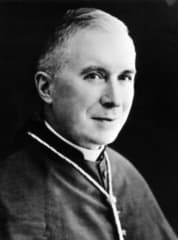アヴェ・マリア・インマクラータ!
愛する兄弟姉妹の皆様、
レネー神父様の霊的講話「幼児洗礼そして堅振について」(日本語訳)をご紹介いたします。
天主様の祝福が豊かにありますように!
トマス小野田圭志神父(聖ピオ十世会司祭)
親愛なる兄弟の皆さん、
一連の公教要理の時間を続けましょう。今は秘蹟について勉強しています。
洗礼についての最後のポイントです。自分の子どもに早く洗礼を受けさせるよう配慮するのは、カトリック信者の親にとっての重い義務です。親が子どもに自然の命と超自然の命の両方を一緒に伝達することが、天主の元々のご計画でした。自らの罪によって、アダムは自然と恩寵を結び付ける原初からの義を失いました。それ以来、恩寵はもはや天主が意図なさっていたように自然に「付属する」ことがなくなってしまいました。それゆえ、子どもは成聖の恩寵を取り去られた状態で生まれるのです。もしアダムが罪を犯さなかったとしたら子どもにあったはずの恩寵が失われている状態、これが原罪なのです。
子どもは自然の命と超自然の命の両方を持つことが天主のご意向でしたから、親は自分の子どもにその超自然の命を、新たな誕生としての洗礼という手段によって授けるのを待ってはいけません。これこそが新たなアダムである私たちの主イエズス・キリストの命であり、子どもたちは洗礼によって主の体の一部となるからです。親が理由もなく子どもに洗礼を受けさせる前に長い間待つことは重い罪です。
すると、次のような反論をする人々がいます。「しかし、子どもはこれについて何も言えません。子どもが選べるようにすべきです」。これは間違った論法です。実際、子どもは自然の命を受けるのも選びません。命を受けるのを選ぶことは誰にもできません! 命は賜物であり、それ自体良いものなのですから、不平を言う余地はまったくありません。命があとでつらい状態になる場合であっても、命それ自体が悪いということを意味しません。そうではなく、命それ自体良いものであり、それゆえに親は子どもに命を与えたことを非難されるべきではありません。教育を受けさせてやらなかったり、親としての世話をしてやらなかったりという落ち度はあるかもしれませんが、命を与えることは落ち度ではありません。同様に、超自然の命は驚くべき賜物であり、自然の命よりもずっと価値がありずっと貴重です。親はそんな賜物を与えることで決して非難されるべきではありません。さらにまた、洗礼のあと良いカトリック教育を受けさせてやる必要があります。そこには落ち度があるかもしれません。しかし、子どもが赤ん坊のときに霊的な命を与えることは間違っていません。
プロテスタントの一部は、彼らの誤ったプロテスタントの信仰のせいで子どもの洗礼を拒否しています。彼らは、洗礼は信仰の宣言の単なるしるしであり、それ自体に効果はないとみなしているからです。そのため彼らは、子どもはその信仰の宣言をすることができないので、洗礼は子どもにとって無益なものだと考えているのです。これは教会の聖伝に反し、幼児洗礼を実践した使徒伝来の聖伝に反しています。幼児洗礼を実践してきたことそれ自体が、まさに、聖アウグスティノによると原罪があることの最も確実な証拠でした。なぜなら子どもには自罪があり得ないので、もし子どもにまったく罪がないとしたら、洗礼は「罪の赦しのために」(使徒行録2章38節)与えられるのですから、洗礼が子どもにとって無益なものだということになってしまうからです。
私たちの主イエズス・キリストはこう言われました。「子どもたちを私のところに来させよ。とめてはならぬ。天主の国を受け入れるのはこのような者たちである」(ルカ18章16節)。キリストのところに来させるためには、洗礼が必要です。洗礼によって、子どもはキリストの体の一部になるからです。それゆえに、私たちの主のこの命令に基づいて、使徒たちと全教会は何世紀にもわたって、常に子どもに洗礼を授けてきました。
聖パウロの書簡の次の一節に、幼児洗礼のヒントが見られるでしょう。それは聖パウロが、カトリック信者でない配偶者が「信者の配偶者と同居するのを承知する」ならば、すなわち、信者である配偶者にカトリック信仰を問題なく実践することを許すならば、信者である配偶者の子は「聖となった」と言うところです。「信者でない夫は信者であるその妻によって聖とされ、信者でない妻は信者であるその夫によって聖とされる。そうでなければ、あなたたちの子どもは汚れたものである。しかし今は聖となった」(コリント前書7章14節)。子どもが聖となったのは、子どもが洗礼を受けているからです。信者でない配偶者が「聖とされ」ているのは、多くの場合そうであったように、それによってその配偶者が回心へと導かれるであろうからです。
さらに、旧約には、幼児洗礼をはっきりと証明する二つのタイプの洗礼があります。割礼は生まれて八日目の幼児に行われました! 聖チプリアノは紀元二五〇年ごろ、次のように質問してきたある司教に答えています。「割礼を八日目まで待ったように、われわれは洗礼を授けるのを八日目まで待つべきであるか?」。聖チプリアノの周りに集まったカルタゴの教会会議は全会一致でこう答えました。「われわれは八日目まで待つことさえすべきでない!」。第二のタイプの洗礼は紅海の渡海です。それについて聖パウロはこう言います。「私たちの先祖は…みな雲と海の中でモーゼにおいて洗われた」(コリント前書10章1-2節)。これは明らかに「水と聖霊によってもう一度生まれる」(ヨハネ3章5節)というキリストにおける洗礼の象徴です。さて、ヘブライ人が赤ん坊を海岸に残したままにせず、赤ん坊も親の腕に抱かれて紅海を渡ったことは明らかですから、それは「有効な」渡海だったのです! ですから幼児洗礼は、答えを代父母が行うとしても、有効な洗礼なのです。
聖書の中で、まことの信仰(復活)に異議を唱えていたサドカイ人に向かって、私たちの主はこう答えられました。「あなたたちは聖書も天主の力も知らぬから誤った考えを持ったのだ」(マルコ12章24節)。皆さんお分かりのように、この御言葉はまたこれらのプロテスタントにも当てはまります。これは幼児洗礼という問題についての一つの例ですが、プロテスタントの全ての誤りについても同様です。しかし、プロテスタントの人々が聖書を理解するためには、私たちの主イエズス・キリストが聖書の管理と信仰の遺産を委託なさった教会の言うことに耳を傾ける必要があります。実際、聖パウロはこう言っています。「天主の家は生きる天主の教会であり、真理の柱であり基である」(ティモテオ前書3章15節)。そして、使徒たちにまで直接さかのぼる教会こそ、カトリック教会なのです。
第二の秘蹟は堅振です。子どもは生まれたあと成長しますし、成長する必要があります! 堅振は、まさにその名の通りのものです。洗礼で受けた命を堅固にし、強め、しっかりさせ、堅実なものにします。堅振は私たちを「キリストの兵士」にすると教会は教えています。実際、一つの戦いがあり、それは罪に対する、悪魔やこの世に対する、そして自らの内にある悪しき傾きに対する戦いです。洗礼の時、私たちは悪魔とそのわざ、その誘惑を捨てました。それは、来るべき戦いがあることを私たちに告げるものだったのです。ですから、そのように強められる必要があるのです。堅振を受けるのは、聖霊の特別な流出によってです。
私たちの主イエズス・キリストは、約束しておられた通り使徒たちと最初の百二十人の弟子たちに聖霊を送られた聖霊降臨の日に、この秘蹟を制定されました。聖霊降臨は大変特別な出来事で、そのとき使徒たちはより優れた方法で、すなわち聖香油ではなく、聖霊の火という実在の炎で堅振を受けました! しかし、聖霊によって霊感を受けた使徒たちは、聖香油を塗り按手をすることによって他の人々にも堅振を授けるべきだと理解しました。
使徒行録の中で、私たちは、堅振と洗礼の間のはっきりとした区別を見ます。助祭フィリッポがサマリアに行き、そこで多くの人々を回心させ、彼らに洗礼を授けました。しかし、それからフィリッポはエルザレムに人を送って使徒たちに来てもらうよう願いました。なぜなら、彼は堅振を授けることができなかったからです。ペトロとヨハネがやって来て新たな受洗者に按手し、それによって彼らは使徒たちが聖霊降臨で受けたのと同じ聖霊の流出を受けました。
このように、堅振の質料は、ひたいの上に十字架のしるしをして聖香油を塗ることです。聖香油はオリーブ油とバルサムを混ぜたものです。聖アルフォンソ・リグオリは、もしバルサムを使わなかったならば、条件付きで再び堅振を受ける必要がある、と言いました。彼は、別の油を使ったかどうかを尋ねることさえしません。彼にとっては、そのようなこと自体およそ考えも及ばないことだったからです! ですから、ノブス・オルドが「オリーブ油またはほかのどの野菜の油でも」使うとしていることによって、無効な堅振への扉を開いてしまっているのです。
オリーブ油は、聖霊降臨のときのような聖霊の火を象徴しています。また聖霊の象徴である鳩は、天主との和解のしるしとして、洪水ののちにオリーブの木の枝をくわえて来ました。平和は聖霊の実の一つだからです(ガラツィア5章22節)。また運動選手は、彼らを強めるために油を塗られました(今でも彼らはあらゆる種類の軟膏を塗ってもらいます)。油を塗るのは、十字架のしるしで、肌のうちで最も見えやすい部分であるひたいの上に行われます。これは、私たちが十字架につけられた私たちの主イエズス・キリストにおいて信仰を告白しなくてはならないことを象徴しています。私たちは「福音を恥としてはならない。福音はすべての信仰者を救う天主の力であるから」(ローマ1章16節)です。
聖伝の堅振の形相は、司教がひたいに油を塗りながら言う次の言葉で成っています。「われ聖父と聖子と聖霊との御名によりて汝に十字架のしるしをなし、救霊(たすかり)の聖香油をもって汝を堅固にす。」
堅振の執行者は司教です。司教は大司祭であり、新たに生まれた信者を完成させることのできる大司祭です。司教は戦闘の教会の指揮官です。この秘蹟の重要性は、授けるために司教を必要とするという事実によって明らかです。非常に特別な場合には、特別な委任によって、司祭がこの秘蹟を有効に執行することができます。司教区が広い場合にあり得るもので、その場合は司教総代理が委任を受けます。あるいは、司教が病気のため、この秘蹟を執行するのに助けを必要とする場合に、その委任がなされます。教皇だけがその委任をすることができます。東方典礼カトリック教会の司祭は、洗礼ののちすぐに堅振を授ける委任を受けていますが、西方教会ではその慣習はありません。
堅振は霊魂にしるしを、殉教にまで至る信仰を告白することができるキリストの兵士としてのしるしを刻印します。実際、聖霊のその特別な賜物、剛毅の賜物は殉教者において明らかになります。彼らは、死も恐ろしい拷問も恐れず、罪を犯すよりはむしろ死を、私たちの主イエズス・キリストを否むよりはむしろ死を選ぶのです。私たちは自分がそのしるしを受けたのだということを覚えておくべきであり、それゆえに罪に対して強くあり、誘惑に対して常に強く「いいえ」と言い、罪に対して「いいえ」と言い、天主に対して「はい」と言うべきです。「でも」や遅れ、ためらいがあってはなりません。どんな状況の下でも、罪を犯すことは決して許されません。私たちの主イエズス・キリストは、絶対の忠実を、死に至る忠実を捧げるのにふさわしいお方です。なぜなら主は、死に至るまで忠実なこれら良き兵士たちに、永遠の栄光の冠を与えてくださるからです。「死ぬまであなたが忠実であれば、私はあなたに命の冠を与えよう」(黙示録2章10節)。
もっと通常の状況であっても、堅振の秘蹟による特別な恩寵は、私たちがキリストの国を拡げるための勇気を持ち、言葉と行いの両方を使ってただ信仰を告白することによって宣教者となるための勇気を持つのを助けてくれます。聖なる生活という証言が、私たちの主の国を拡げるための素晴らしい手段なのです。
堅振の秘蹟は生きている者の秘蹟です。堅振を受けるためには成聖の恩寵の状態でなければなりません。罪の状態で堅振を受ければ汚聖になります。子どもが青年期の霊的な課題を克服するための準備をし、信仰において強くなるように、十二歳より前に子どもに堅振を受けさせるのは良いことです。子どもに堅振を受けさせることは親の義務です。
堅信の儀式は単純ですが重要です。この儀式は、聖霊降臨の晩課の讃歌である「ヴェニ・サンクテ・スピリトゥス(聖霊よ来り給え)」を歌うことによって、聖霊を荘厳に呼び求めることで始まります。その後、全員がひざまずき、司教が立ち上がって全員の上に両手を広げて、イザヤの預言に従って七つの霊を呼び求めます。「その上に主の霊がやどる。知恵と分別の霊、賢慮と強さの霊、知識と主への恐れの霊が。彼は、主へのおそれをよろこびとする」(イザヤ11章2-3節)。
それから司教は座り、受堅者が一人ずつ順番に司教に近づいて足元にひざまずき、代父または代母が右手を受堅者の右肩に置いたまま受堅者の後ろに立ちます。司教は親指に聖香油をつけ、それから両手を受堅者の頭に置いて、次のように言いながら親指でひたいに十字架の形に聖香油を塗ります。「われ聖父と聖子と聖霊との御名によりて汝に十字架のしるしをなし、救霊(たすかり)の聖香油をもって汝を堅固にす」。受堅者は「アーメン」と答えます。これが、秘蹟そのものが授けられるまさにその瞬間です。その後、司教は、受堅者の強さや耐える力を調べる象徴として、受堅者の頰を軽く打ちます。
最後の祈りは、私たちが聖霊の神殿であることを思い出させてくれます。そのあと最も重要なのは、堅振を受けたばかりの人々が、使徒信経を唱えることによって公に信仰を告白することです。そのとき彼らは、生涯の終わりまで今告白しているその信仰を守る準備のできた兵士としてそこに立っているのです。また、あらゆる祈りの模範である「天にまします」も唱えます。祈りによって、勝利の恩寵を受けることになるからです。また、最も良く使う祈りである「めでたし」も唱えます。マリア様は私たちの主と分かちがたいお方だからです。
聖霊に満たされて、お告げの日にイエズスの御母となり給い、聖霊降臨の日に教会の御母となり給うた殉教者の元后である聖母が、堅振を受けるすべての人をその特別な御保護のもとに置き、彼らがキリストのまことの兵士となるようお助けくださいますように! 「無原罪の聖母の騎士」となることは、私たちに自分の堅振を思い出させ、天国での永遠の報いに至るまで私たちを助けてまことに騎士として生きるようにしてくれる、私たち全員にとって大きな助けなのです。アーメン。
愛する兄弟姉妹の皆様、
レネー神父様の霊的講話「幼児洗礼そして堅振について」(日本語訳)をご紹介いたします。
天主様の祝福が豊かにありますように!
トマス小野田圭志神父(聖ピオ十世会司祭)
2016年11月13日 聖霊降臨後の第26主日―大阪 霊的講話「幼児洗礼そして堅振について」
親愛なる兄弟の皆さん、
一連の公教要理の時間を続けましょう。今は秘蹟について勉強しています。
洗礼についての最後のポイントです。自分の子どもに早く洗礼を受けさせるよう配慮するのは、カトリック信者の親にとっての重い義務です。親が子どもに自然の命と超自然の命の両方を一緒に伝達することが、天主の元々のご計画でした。自らの罪によって、アダムは自然と恩寵を結び付ける原初からの義を失いました。それ以来、恩寵はもはや天主が意図なさっていたように自然に「付属する」ことがなくなってしまいました。それゆえ、子どもは成聖の恩寵を取り去られた状態で生まれるのです。もしアダムが罪を犯さなかったとしたら子どもにあったはずの恩寵が失われている状態、これが原罪なのです。
子どもは自然の命と超自然の命の両方を持つことが天主のご意向でしたから、親は自分の子どもにその超自然の命を、新たな誕生としての洗礼という手段によって授けるのを待ってはいけません。これこそが新たなアダムである私たちの主イエズス・キリストの命であり、子どもたちは洗礼によって主の体の一部となるからです。親が理由もなく子どもに洗礼を受けさせる前に長い間待つことは重い罪です。
すると、次のような反論をする人々がいます。「しかし、子どもはこれについて何も言えません。子どもが選べるようにすべきです」。これは間違った論法です。実際、子どもは自然の命を受けるのも選びません。命を受けるのを選ぶことは誰にもできません! 命は賜物であり、それ自体良いものなのですから、不平を言う余地はまったくありません。命があとでつらい状態になる場合であっても、命それ自体が悪いということを意味しません。そうではなく、命それ自体良いものであり、それゆえに親は子どもに命を与えたことを非難されるべきではありません。教育を受けさせてやらなかったり、親としての世話をしてやらなかったりという落ち度はあるかもしれませんが、命を与えることは落ち度ではありません。同様に、超自然の命は驚くべき賜物であり、自然の命よりもずっと価値がありずっと貴重です。親はそんな賜物を与えることで決して非難されるべきではありません。さらにまた、洗礼のあと良いカトリック教育を受けさせてやる必要があります。そこには落ち度があるかもしれません。しかし、子どもが赤ん坊のときに霊的な命を与えることは間違っていません。
プロテスタントの一部は、彼らの誤ったプロテスタントの信仰のせいで子どもの洗礼を拒否しています。彼らは、洗礼は信仰の宣言の単なるしるしであり、それ自体に効果はないとみなしているからです。そのため彼らは、子どもはその信仰の宣言をすることができないので、洗礼は子どもにとって無益なものだと考えているのです。これは教会の聖伝に反し、幼児洗礼を実践した使徒伝来の聖伝に反しています。幼児洗礼を実践してきたことそれ自体が、まさに、聖アウグスティノによると原罪があることの最も確実な証拠でした。なぜなら子どもには自罪があり得ないので、もし子どもにまったく罪がないとしたら、洗礼は「罪の赦しのために」(使徒行録2章38節)与えられるのですから、洗礼が子どもにとって無益なものだということになってしまうからです。
私たちの主イエズス・キリストはこう言われました。「子どもたちを私のところに来させよ。とめてはならぬ。天主の国を受け入れるのはこのような者たちである」(ルカ18章16節)。キリストのところに来させるためには、洗礼が必要です。洗礼によって、子どもはキリストの体の一部になるからです。それゆえに、私たちの主のこの命令に基づいて、使徒たちと全教会は何世紀にもわたって、常に子どもに洗礼を授けてきました。
聖パウロの書簡の次の一節に、幼児洗礼のヒントが見られるでしょう。それは聖パウロが、カトリック信者でない配偶者が「信者の配偶者と同居するのを承知する」ならば、すなわち、信者である配偶者にカトリック信仰を問題なく実践することを許すならば、信者である配偶者の子は「聖となった」と言うところです。「信者でない夫は信者であるその妻によって聖とされ、信者でない妻は信者であるその夫によって聖とされる。そうでなければ、あなたたちの子どもは汚れたものである。しかし今は聖となった」(コリント前書7章14節)。子どもが聖となったのは、子どもが洗礼を受けているからです。信者でない配偶者が「聖とされ」ているのは、多くの場合そうであったように、それによってその配偶者が回心へと導かれるであろうからです。
さらに、旧約には、幼児洗礼をはっきりと証明する二つのタイプの洗礼があります。割礼は生まれて八日目の幼児に行われました! 聖チプリアノは紀元二五〇年ごろ、次のように質問してきたある司教に答えています。「割礼を八日目まで待ったように、われわれは洗礼を授けるのを八日目まで待つべきであるか?」。聖チプリアノの周りに集まったカルタゴの教会会議は全会一致でこう答えました。「われわれは八日目まで待つことさえすべきでない!」。第二のタイプの洗礼は紅海の渡海です。それについて聖パウロはこう言います。「私たちの先祖は…みな雲と海の中でモーゼにおいて洗われた」(コリント前書10章1-2節)。これは明らかに「水と聖霊によってもう一度生まれる」(ヨハネ3章5節)というキリストにおける洗礼の象徴です。さて、ヘブライ人が赤ん坊を海岸に残したままにせず、赤ん坊も親の腕に抱かれて紅海を渡ったことは明らかですから、それは「有効な」渡海だったのです! ですから幼児洗礼は、答えを代父母が行うとしても、有効な洗礼なのです。
聖書の中で、まことの信仰(復活)に異議を唱えていたサドカイ人に向かって、私たちの主はこう答えられました。「あなたたちは聖書も天主の力も知らぬから誤った考えを持ったのだ」(マルコ12章24節)。皆さんお分かりのように、この御言葉はまたこれらのプロテスタントにも当てはまります。これは幼児洗礼という問題についての一つの例ですが、プロテスタントの全ての誤りについても同様です。しかし、プロテスタントの人々が聖書を理解するためには、私たちの主イエズス・キリストが聖書の管理と信仰の遺産を委託なさった教会の言うことに耳を傾ける必要があります。実際、聖パウロはこう言っています。「天主の家は生きる天主の教会であり、真理の柱であり基である」(ティモテオ前書3章15節)。そして、使徒たちにまで直接さかのぼる教会こそ、カトリック教会なのです。
第二の秘蹟は堅振です。子どもは生まれたあと成長しますし、成長する必要があります! 堅振は、まさにその名の通りのものです。洗礼で受けた命を堅固にし、強め、しっかりさせ、堅実なものにします。堅振は私たちを「キリストの兵士」にすると教会は教えています。実際、一つの戦いがあり、それは罪に対する、悪魔やこの世に対する、そして自らの内にある悪しき傾きに対する戦いです。洗礼の時、私たちは悪魔とそのわざ、その誘惑を捨てました。それは、来るべき戦いがあることを私たちに告げるものだったのです。ですから、そのように強められる必要があるのです。堅振を受けるのは、聖霊の特別な流出によってです。
私たちの主イエズス・キリストは、約束しておられた通り使徒たちと最初の百二十人の弟子たちに聖霊を送られた聖霊降臨の日に、この秘蹟を制定されました。聖霊降臨は大変特別な出来事で、そのとき使徒たちはより優れた方法で、すなわち聖香油ではなく、聖霊の火という実在の炎で堅振を受けました! しかし、聖霊によって霊感を受けた使徒たちは、聖香油を塗り按手をすることによって他の人々にも堅振を授けるべきだと理解しました。
使徒行録の中で、私たちは、堅振と洗礼の間のはっきりとした区別を見ます。助祭フィリッポがサマリアに行き、そこで多くの人々を回心させ、彼らに洗礼を授けました。しかし、それからフィリッポはエルザレムに人を送って使徒たちに来てもらうよう願いました。なぜなら、彼は堅振を授けることができなかったからです。ペトロとヨハネがやって来て新たな受洗者に按手し、それによって彼らは使徒たちが聖霊降臨で受けたのと同じ聖霊の流出を受けました。
このように、堅振の質料は、ひたいの上に十字架のしるしをして聖香油を塗ることです。聖香油はオリーブ油とバルサムを混ぜたものです。聖アルフォンソ・リグオリは、もしバルサムを使わなかったならば、条件付きで再び堅振を受ける必要がある、と言いました。彼は、別の油を使ったかどうかを尋ねることさえしません。彼にとっては、そのようなこと自体およそ考えも及ばないことだったからです! ですから、ノブス・オルドが「オリーブ油またはほかのどの野菜の油でも」使うとしていることによって、無効な堅振への扉を開いてしまっているのです。
オリーブ油は、聖霊降臨のときのような聖霊の火を象徴しています。また聖霊の象徴である鳩は、天主との和解のしるしとして、洪水ののちにオリーブの木の枝をくわえて来ました。平和は聖霊の実の一つだからです(ガラツィア5章22節)。また運動選手は、彼らを強めるために油を塗られました(今でも彼らはあらゆる種類の軟膏を塗ってもらいます)。油を塗るのは、十字架のしるしで、肌のうちで最も見えやすい部分であるひたいの上に行われます。これは、私たちが十字架につけられた私たちの主イエズス・キリストにおいて信仰を告白しなくてはならないことを象徴しています。私たちは「福音を恥としてはならない。福音はすべての信仰者を救う天主の力であるから」(ローマ1章16節)です。
聖伝の堅振の形相は、司教がひたいに油を塗りながら言う次の言葉で成っています。「われ聖父と聖子と聖霊との御名によりて汝に十字架のしるしをなし、救霊(たすかり)の聖香油をもって汝を堅固にす。」
堅振の執行者は司教です。司教は大司祭であり、新たに生まれた信者を完成させることのできる大司祭です。司教は戦闘の教会の指揮官です。この秘蹟の重要性は、授けるために司教を必要とするという事実によって明らかです。非常に特別な場合には、特別な委任によって、司祭がこの秘蹟を有効に執行することができます。司教区が広い場合にあり得るもので、その場合は司教総代理が委任を受けます。あるいは、司教が病気のため、この秘蹟を執行するのに助けを必要とする場合に、その委任がなされます。教皇だけがその委任をすることができます。東方典礼カトリック教会の司祭は、洗礼ののちすぐに堅振を授ける委任を受けていますが、西方教会ではその慣習はありません。
堅振は霊魂にしるしを、殉教にまで至る信仰を告白することができるキリストの兵士としてのしるしを刻印します。実際、聖霊のその特別な賜物、剛毅の賜物は殉教者において明らかになります。彼らは、死も恐ろしい拷問も恐れず、罪を犯すよりはむしろ死を、私たちの主イエズス・キリストを否むよりはむしろ死を選ぶのです。私たちは自分がそのしるしを受けたのだということを覚えておくべきであり、それゆえに罪に対して強くあり、誘惑に対して常に強く「いいえ」と言い、罪に対して「いいえ」と言い、天主に対して「はい」と言うべきです。「でも」や遅れ、ためらいがあってはなりません。どんな状況の下でも、罪を犯すことは決して許されません。私たちの主イエズス・キリストは、絶対の忠実を、死に至る忠実を捧げるのにふさわしいお方です。なぜなら主は、死に至るまで忠実なこれら良き兵士たちに、永遠の栄光の冠を与えてくださるからです。「死ぬまであなたが忠実であれば、私はあなたに命の冠を与えよう」(黙示録2章10節)。
もっと通常の状況であっても、堅振の秘蹟による特別な恩寵は、私たちがキリストの国を拡げるための勇気を持ち、言葉と行いの両方を使ってただ信仰を告白することによって宣教者となるための勇気を持つのを助けてくれます。聖なる生活という証言が、私たちの主の国を拡げるための素晴らしい手段なのです。
堅振の秘蹟は生きている者の秘蹟です。堅振を受けるためには成聖の恩寵の状態でなければなりません。罪の状態で堅振を受ければ汚聖になります。子どもが青年期の霊的な課題を克服するための準備をし、信仰において強くなるように、十二歳より前に子どもに堅振を受けさせるのは良いことです。子どもに堅振を受けさせることは親の義務です。
堅信の儀式は単純ですが重要です。この儀式は、聖霊降臨の晩課の讃歌である「ヴェニ・サンクテ・スピリトゥス(聖霊よ来り給え)」を歌うことによって、聖霊を荘厳に呼び求めることで始まります。その後、全員がひざまずき、司教が立ち上がって全員の上に両手を広げて、イザヤの預言に従って七つの霊を呼び求めます。「その上に主の霊がやどる。知恵と分別の霊、賢慮と強さの霊、知識と主への恐れの霊が。彼は、主へのおそれをよろこびとする」(イザヤ11章2-3節)。
それから司教は座り、受堅者が一人ずつ順番に司教に近づいて足元にひざまずき、代父または代母が右手を受堅者の右肩に置いたまま受堅者の後ろに立ちます。司教は親指に聖香油をつけ、それから両手を受堅者の頭に置いて、次のように言いながら親指でひたいに十字架の形に聖香油を塗ります。「われ聖父と聖子と聖霊との御名によりて汝に十字架のしるしをなし、救霊(たすかり)の聖香油をもって汝を堅固にす」。受堅者は「アーメン」と答えます。これが、秘蹟そのものが授けられるまさにその瞬間です。その後、司教は、受堅者の強さや耐える力を調べる象徴として、受堅者の頰を軽く打ちます。
最後の祈りは、私たちが聖霊の神殿であることを思い出させてくれます。そのあと最も重要なのは、堅振を受けたばかりの人々が、使徒信経を唱えることによって公に信仰を告白することです。そのとき彼らは、生涯の終わりまで今告白しているその信仰を守る準備のできた兵士としてそこに立っているのです。また、あらゆる祈りの模範である「天にまします」も唱えます。祈りによって、勝利の恩寵を受けることになるからです。また、最も良く使う祈りである「めでたし」も唱えます。マリア様は私たちの主と分かちがたいお方だからです。
聖霊に満たされて、お告げの日にイエズスの御母となり給い、聖霊降臨の日に教会の御母となり給うた殉教者の元后である聖母が、堅振を受けるすべての人をその特別な御保護のもとに置き、彼らがキリストのまことの兵士となるようお助けくださいますように! 「無原罪の聖母の騎士」となることは、私たちに自分の堅振を思い出させ、天国での永遠の報いに至るまで私たちを助けてまことに騎士として生きるようにしてくれる、私たち全員にとって大きな助けなのです。アーメン。










